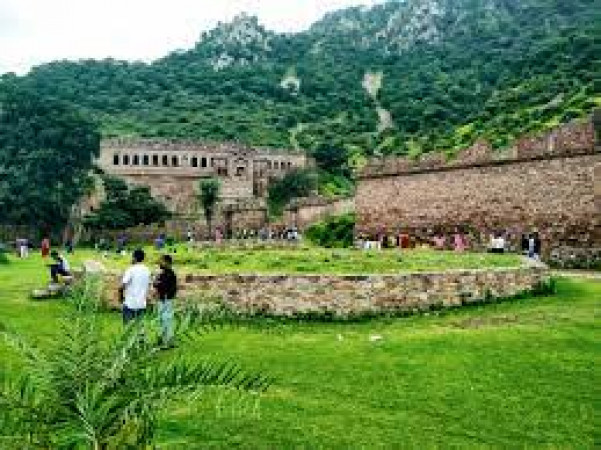Bhangarh Fort Travel Guide
Bhangarh Fort, located in Rajasthan, India, is a historical site known for its eerie reputation as one of the most haunted places in Asia. This 17th-century fort is nestled at the edge of the Sariska Tiger Reserve and holds a significant place in Indian history due to its architectural beauty and mysterious legends surrounding its abandonment. Visitors flock to Bhangarh Fort not only for its historical significance but also for the thrill of exploring its haunted ruins and picturesque surroundings.Top Attractions in Bhangarh Fort
- Bhangarh Fort Ruins
- Gopinath Temple
- Sariska Tiger Reserve
- Ajabgarh Fort
- Haunted Tales of Bhangarh
Bhangarh Fort is Famous for
Known for its haunted reputation, Bhangarh Fort is famous for being one of the most ghostly places in India.Top Attractions in Bhangarh Fort
- Explore the ancient ruins of Bhangarh Fort
- Visit the mystical Gopinath Temple
- Experience wildlife at Sariska Tiger Reserve
- Discover the history of Ajabgarh Fort
- Hear the eerie haunted tales of Bhangarh
What's Great about Travelling to Bhangarh Fort?
- Adventure seekers looking for a spooky experience
- History enthusiasts interested in exploring ancient ruins
- Nature lovers wanting to visit the nearby wildlife reserve
What's Not So Great about Travelling to Bhangarh Fort?
- Those who are easily scared or superstitious
- Visitors seeking luxurious accommodations
- Travelers looking for a bustling nightlife scene
Travel Tips for Bhangarh Fort
- Respect the local beliefs and legends surrounding the fort
- Wear comfortable shoes for exploring the ruins
- Carry water and snacks as facilities are limited in the area
Important Bhangarh Fort trip information
- Ideal Duration: 1-2 days
- Best Time to Visit: October to March
- Nearby Airports and Railway Stations: Jaipur Airport (80 km) and Dausa Railway Station (35 km)
FAQ's on Bhangarh Fort
Q1: What is the best time to visit Bhangarh Fort?
The best time to visit Bhangarh Fort is during the winter months from October to March when the weather is pleasant and ideal for exploring the historic site without extreme heat. Additionally, visiting during the monsoon season can offer a lush and green landscape, but be prepared for occasional rainfall. It is advisable to avoid the summer months due to scorching temperatures.
Q2: Do I need a visa to travel to Bhangarh Fort?
As Bhangarh Fort is located in India, tourists from most countries will need a valid tourist visa to enter the country. Make sure to check the specific visa requirements based on your nationality and duration of stay. Exceptions or special considerations may apply, so it is recommended to verify the latest information with the Indian embassy or consulate.
Q3: What are the must-visit attractions in Bhangarh Fort?
Bhangarh Fort itself is the primary attraction, known for its historical significance and eerie legends. Visitors should explore the fort's various structures, temples, and the beautiful surrounding landscape. Additionally, the nearby Sariska Tiger Reserve and Siliserh Lake are popular destinations for nature lovers.
Q4: Is Bhangarh Fort a safe place to travel?
Bhangarh Fort is generally safe for tourists to visit during the daytime. However, it is advised not to stay inside the fort premises after sunset, as it is believed to be haunted and entry is prohibited by the Archaeological Survey of India during night hours. As with any travel destination, it is recommended to be cautious of your surroundings and belongings.
Q5: What is the local currency in Bhangarh Fort and can I use credit cards?
The local currency in Bhangarh Fort is the Indian Rupee (INR). While credit cards are accepted in some hotels and larger establishments, it is advisable to carry cash for smaller vendors and local markets. ATMs are available in nearby towns for convenient access to money.
Q6: What is the local cuisine like in Bhangarh Fort?
is situated in Rajasthan, known for its rich and flavorful cuisine. Visitors can enjoy traditional Rajasthani dishes such as Dal Baati Churma, Gatte ki Sabzi, and Laal Maas. Vegetarian options like Ker Sangri and Bajra Roti are also popular. Make sure to try local sweets like Ghevar and Mawa Kachori for a delightful culinary experience.
Q7: What transportation options are available in Bhangarh Fort?
Transportation options in Bhangarh Fort include buses, taxis, and private cars. Visitors can hire a taxi or opt for a guided tour from nearby cities like Jaipur or Alwar. Public buses also connect Bhangarh Fort to major towns in Rajasthan. It is recommended to arrange transportation in advance for a convenient visit.
Q8: Are there any cultural norms or etiquette I should be aware of when visiting Bhangarh Fort?
When visiting Bhangarh Fort and other sites in Rajasthan, it is important to respect local customs and traditions. Dress modestly, especially when visiting religious sites, and remove your shoes before entering temples or shrines. Always ask for permission before taking photographs of locals, and be mindful of cultural sensitivities. Greeting people with a "Namaste" is a common and respectful way to interact.
Q9: I am a travel agent. How can I buy travel leads of Bhangarh Fort?
Register yourself as a travel agent at agents.tripclap.com and then you can buy travel leads to Bhangarh Fort once your account is approved. For more details contact our support team at +91-8069186564 or support@tripclap.com

